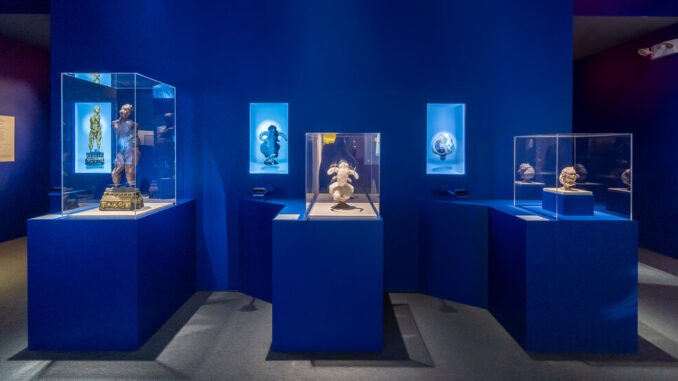
Installed on vintage hardware at the Museum of the Moving Image in Astoria, Queens, laid out chronologically, the first career survey of the innovative Net artist Auriea Harvey tells a story about mortality, and survival.
In Harvey’s jewel-box worlds, there aren’t heroes or villains, just people, losing and loving, enmeshed in the slipstream of tech.
Harvey, born in 1971 in Indianapolis, helped expand the vistas of digital art — utopias, games, crashes and all. In the 1990s, she created boundary-bending imagery with GIFs, Shockwave animations, and the HTML and Java programming languages. Her sumptuous personal website, Entropy8.com, restored for the show, won Webby Awards in 1997 and ’98.
In the last few years, Harvey turned to sculpting imaginary but mythic-seeming artifacts that exist as both 3-D printed statuary and glossy virtual models. At the museum, you can make several rotate on transparent screens by waving your hand. The “mixed reality” sculptures incorporate scans of ancient artwork, hand-shaped clay and her own facial features — they look cracked, weathered, instantly timeless.
With each technological shift, the scintillation of new possibilities meets the tug of obsolescence.
Her story is also a cybernetic romance. As the show’s title puts it: “My veins are the wires. My body is your keyboard.” The wires are everyone’s, but the keyboard is only for “you” — invoking the as-yet-irreplicable intimacy of a lover’s touch.
In 1999 Harvey found love on a site called Hell.com, a portal for hackers, artists and digital misfits. There, she met Michael Samyn, a Belgian digital artist working as Zuper!; he’s been her romantic and creative partner ever since.
Within months of their meet-cute, Harvey moved to Belgium. (Now married, they live in Rome.) In this exhibition, organized by Regina Harsanyi, Harvey’s solo projects bookend the couple’s collaborations. As Entropy8Zuper!, they undertook public displays of affection, radical for their exhibitionism, yet heightened by mystery. Their work imbued the machine realm of code and terminals with intimate poetry.
On view is a recording of a 1999 performance, “Whispering Windows,” where the lovers shared sultry words on crunchy, low-bandwidth webcams as an audience watched from their own screens. Another monitor displays one of the couple’s erotic chat- room sessions. In 1999 Harvey and Samyn compiled the animated love letters they’d exchanged through a secret Hell.com subfolder as the website “Skinonskinonskin,” and sold subscriptions. On one page, you can “stroke” an image of Harvey’s face with your cursor, and “she” turns her head.
Like Hell.com, Harvey’s work was meant to be arcane and sometimes baffling — and to reward the curious. The show features influential projects by Entropy8Zuper!, such as “The Godlove Museum,” a gothic and prankish digital novella that narrates their romance through abstract mini-games and sometimes violent animations. On one page the user has to smash the screen with virtual rocks, and the broken glass bleeds.
Clearly, they were having fun. In the same gallery, a blotchy video clip shows the couple accepting a Webby in 2000; they spent their time at the podium making out. Later, they turned this image of their entwined bodies into a 3-D model, titled “The Kiss,” which viewers can explore on a nearby screen.
In 2003, Harvey and Samyn founded an indie video game company called Tale of Tales. Like their web-based projects, their video games feature atmospheric settings, slow pacing, diverse characters and open-ended (or endless) stories, more like real life than movies.
Four major titles are playable on large projections in the retrospective (with play-through videos of two others, plus two interactive mobile games). On each of my visits, though, at least one had crashed — apparently, it’s not easy keeping creaky hardware running for hours on end.
In their cult hit “The Path,” a short horror game from 2009 that riffs on the darker folklore of Little Red Riding Hood, your sole instruction is to “stay on the path” to Grandma’s, but most of the thrills unfold when you disobey and plunge into the woods. The hallucinatory “Bientôt l’été,” from 2012, consists largely of a stroll along a dreamlike, holographic beach; closing your avatar’s eyes is an essential game mechanic.
Tale of Tales has many fans in the gaming community, but after the disappointing sales of their 2015 title “Sunset,” a somewhat stodgy chore-based game starring a housekeeper maintaining a penthouse during a civil war, they announced their bitter exit from the industry.
Harvey and Samyn came of age on the halcyon internet, when indie artists weren’t creating online content, they were building worlds. Almost instantly, these worlds began to fade.
You might wonder why you’d journey to Astoria for a show of web-based art and video games, many of which you can still download. The lurch into digital obscurity is one reason. Harvey’s work — and that of many other net artists — took a big hit in 2021 when major web browsers discontinued support for the Flash plug-in that powers many online projects. Rhizome, an organization that preserves digital art, has restored a handful of Entropy8 and Entropy8Zuper! projects for this exhibition.
But entropy has always heightened the beauty of Harvey’s art.
Auriea Harvey
Through July 7, Museum of the Moving Image, 36-01 35 Avenue, Astoria; 718–777–6800, movingimage.org.


Be the first to comment